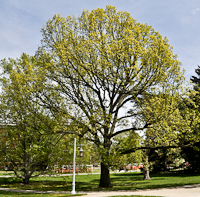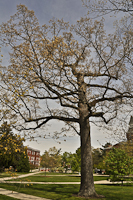 Once a tree is mature (fully grown), it
may require occasional pruning to remove dead, weakened, diseased or
insect infested branches. Sometimes branches will be removed to provide
head room for mowing or car access. At times, the structure of the tree
skeleton may be need to be adjusted by pruning to thin out the canopy.
Once a tree is mature (fully grown), it
may require occasional pruning to remove dead, weakened, diseased or
insect infested branches. Sometimes branches will be removed to provide
head room for mowing or car access. At times, the structure of the tree
skeleton may be need to be adjusted by pruning to thin out the canopy.
Each tree species or cultivar has a
mature height and spread that it is destined to attain. You should make
every effort to allow it to grow to its natural size and shape. Of
course, you have the power saws so you can cut it into any size or shape
that you like. However, doing this will probably impact the health of
the tree and the trunk will soon get out of proportion with the severely
trimmed canopy.
 If you must try to control the ultimate
height of the tree, it is best to start with a little pruning each year
when the tree is young. Waiting until it is full grown to begin
controlling the height will result in problems. A drastic form of this
is called topping.
If you must try to control the ultimate
height of the tree, it is best to start with a little pruning each year
when the tree is young. Waiting until it is full grown to begin
controlling the height will result in problems. A drastic form of this
is called topping.
Large limbs must be cut with a saw. The recommended
procedure is to remove a larger limbs in either a
two or three step process.
For extremely large branches or ones that are high in the tree, it is
best to have the job done by a professional arborist. They have the
equipment to do it safely and properly.



